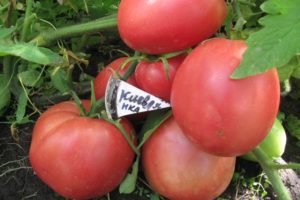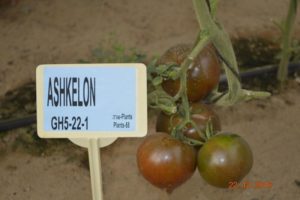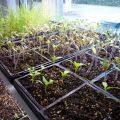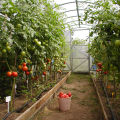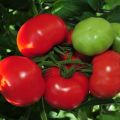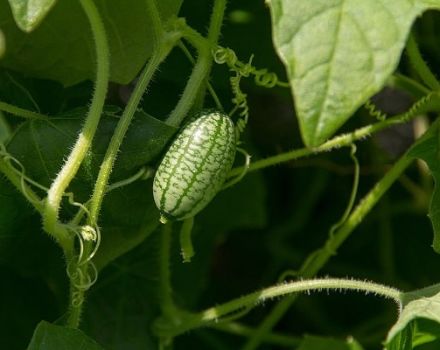Varieties of the best and most productive tomatoes for the Urals in a greenhouse
Tomato varieties for the Urals in a greenhouse are characterized by low susceptibility to temperature fluctuations and most diseases against which plants bred for open ground in warm latitudes are defenseless.
The most productive varieties are bred by sectioning, and the result is hybrid species that meet the best taste and small claims regarding external conditions.
Features of growing tomatoes in the Urals
The growing season of fruits of the nightshade family does not fit into the modest framework of the short Ural summer, therefore it is recommended to plant seedlings in greenhouses. Great importance is attached to the choice of a tomato variety for greenhouses, which gives a yield no less than related plant species grown under more gentle conditions.
Having selected a suitable variety according to the characterizing description, you need to purchase seeds from a trusted seller and proceed with their primary processing, which will necessarily include hardening of each seed - this procedure is all the more necessary, the more complex the temperature conditions of the area of the planned planting.
The best tomato varieties for the Urals are given below, but even from the most unpretentious plant it will not be possible to get a complete harvest of fruits if you make a mistake with the choice of a variety or skip an important stage in preparing tomatoes for planting. But which varieties are best?
How to choose and prepare seeds for planting
When choosing tomato seeds for the Urals, it is important to correctly read the information on the packaging, because the container itself is tightly closed and there is no other way to make sure the quality of the seeds and their characteristics. Moreover, the reading should be, rather, between the lines, since, indicating the characteristics of the species, the manufacturer tries to smooth out the negative aspects as much as possible, covering them with insignificant or dubious advantages. So, the inscription "disease resistance" is, in fact, empty information, because it does not carry information about the immunity to which diseases is embedded in the plant.

"Good taste" indicates an unsuccessful hybrid with many flavors - a C grade, so to speak. "Well transported" together with "not prone to cracking" is most likely a hard fruit, similar in density to an apple and with sinewy, dry contents. The same applies to the high indicated shelf life of ripe fruits.
Even the most productive varieties of tomatoes, which yield huge harvests in the southern latitudes, will disappoint the gardener of the Middle or Northern Urals. It is best to use breeding specimens that have been tested in the area where they are planned to be grown.
Among such, unpretentious and well-adapted in the greenhouse varieties of tomatoes for the Urals are: "Yantarny", "Zvezdochka", "Ladoga", "Nevsky".
Seed preparation
If the gardener already has experience in growing tomatoes and the previous harvest pleased with the result, it is best to use seeds harvested by hand, rather than purchased. For this, ripe fruits are carefully selected from the strongest and healthiest bushes, and you need to take those that have grown on the lowest brushes. Then the selected fruits can be removed anywhere so that they can lie quietly until the tomato pulp is liquefied.
Before sowing, in spring, the seeds must be sorted out, separating empty and low-quality grains. It is easy to do this - dilute 5% saline solution in a deep bowl, pour all the dried seeds into it and stir so that they are well wet. Those seeds that sink to the bottom of the bowl can be planted. The rest are collected from the surface of the water and discarded.
The next stage is to inoculate the future plant with resistance to certain diseases, like a streak. Such prevention is mandatory, since a tomato for the Urals in a greenhouse is exposed to many dangers that would be easier to deal with in the open field.
The etching is carried out as follows: 1 g of crystalline manganese is dissolved in half a glass of warm water and the seeds are added there for ten minutes. It is imperative that after the procedure, the seeds are washed with settled water and dried, spreading them in one layer on a napkin.
Hardening is one of the most important points that determine the quality and volume of the future harvest. To do this, the grains are soaked in water for two days 18-21 C, then put them in ice water, poured into a saucer and rearranged in the freezer. It is necessary to ensure that the temperature in the chamber does not drop below -3 C. After such preparation, seeds for planting tomatoes in the Urals are ready for sowing in boxes.
The best varietal choice
The following species presented in the description were not chosen by chance, but according to the number of positive reviews from practicing gardeners who grow tomatoes in unpredictable short summer conditions. The varieties were selected due to their positive attitude to the greenhouse microclimate, immunity to many diseases and yield.

Pink honey
The species is determinant, medium early and is used for a greenhouse when planting seedlings. Of all the pink varieties of tomatoes, "honey" ripens first. The yield of the species is from 3.2 to 3.7 kg of fruits per 1 m2 under conditions of proper watering and nutrition of the soil.
The bush is represented by a stem with a small amount of dark green leaves that grows in a greenhouse up to 1.5 m tall. The recommended formation of a bush is 1-2 stems. In the first case, all stepson's shoots are removed from the plant, in the second - all but one formed immediately under the inflorescence. This variety is considered to be moderately resistant to disease.
The fruits grow large, from 0.3 to 0.7 kg, in the shape of a heart; ripening color - pink with a raspberry tint. The pulp is sugar, fleshy, suitable only for fresh consumption or for preparing first and second courses. The fruit is not recommended for conservation, it is not stored for long and deteriorates quickly.
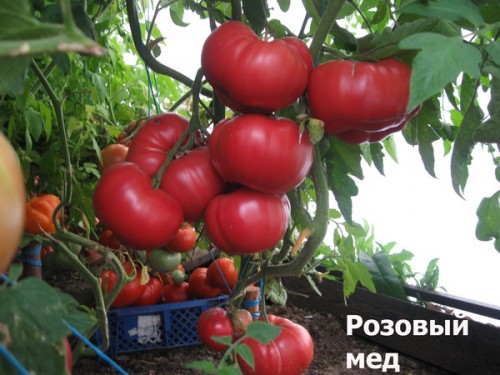
Caspar F1
An unpretentious determinant view for closed ground Caspar F1, ideal for various types of conservation and suitable for storage in boxes. Reduced susceptibility to disease and high-grade harvests demonstrated by the variety make it possible for novice gardeners to turn to its cultivation. From 1 m2 7-9 kg of vegetables are harvested.
Greenhouse tomatoes can be harvested already on the 90th day, which is approximately mid-August in the Middle Urals. Even in adult form, the hybrid is rarely invaded by insects and this is one of the reasons for its long fruiting.
Tomatoes have a characteristic elongated shape reminiscent of sweet peppers; on ripening, they acquire a red color with a rich orange tint. The taste reflects a slight sourness. Fruits are small in size, weighing from 0.08 to 0.12 kg, do not crack. The only drawback that is noticeable when using fresh tomatoes is a very dense, "film" skin.

Bull heart
A mid-season, determinant species for closed ground, yielding a crop in 4 months from the moment of the first shoots, while the average yield from a bush in a greenhouse is within 10 kg. The bush is a tall and strong, up to 2 meters, stem formation with few leaves. The formation of the 5th or 6th fruit cluster contributes to the arrest of plant growth.
The brush produces 3-5 tomatoes, and the size of the fruits depends on the position of the brush on the bush - the higher the stalk is, the smaller the fruits on it. The ovary formed above 8-9 leaves, that is, located below all, gives the largest tomatoes, up to 0.5 kg. The vegetables are heart-shaped, deep red in color, with a thin, easily peeled skin.
The "Bull's Heart" does not have a very high resistance to disease, and if a vegetable gets sick (especially with late blight), it quickly infects all nearby plants.
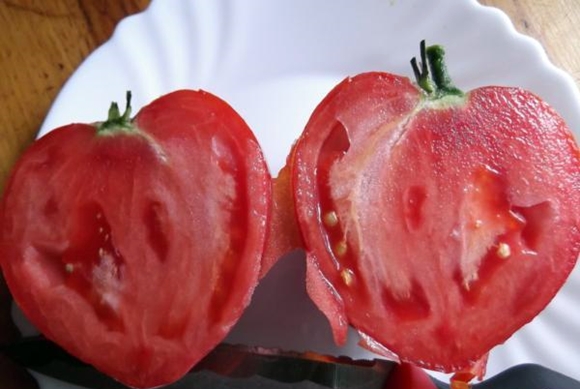
Tornado F1
A hybrid species belonging to the mid-early, determinant varieties with a stem type. The first collection of fruits is carried out 100-105 days after planting seedlings in the soil. The yield is high, about 7 kg from each bush.
The bush grows up to 2 m, medium spreading, which allows you to plant 1 m2 up to 3 plants. The species is not susceptible to the following diseases:
- fusarium;
- cladosporiosis;
- verticillosis.
Growing tomato tornado F1 beneficial from the point of view of a commercial enterprise. The leading factor that can lead to a negative reaction is a violation of the irrigation regime during the period of active development.
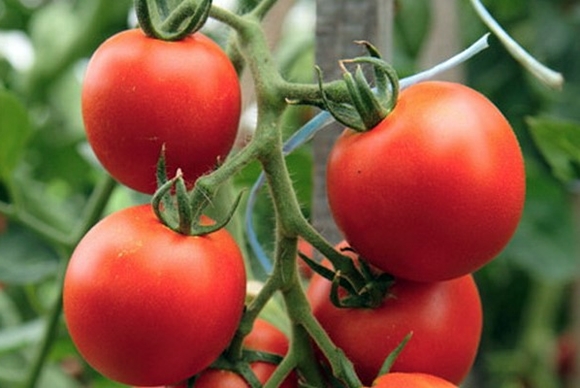
Eagle heart
These tomatoes for a polycarbonate greenhouse are indeterminate species with a bush height of about one and a half meters. The bushes form a powerful leafy stem with small, expressionless flowers, collected in an inflorescence. The variety is resistant to diseases, but before planting, it is required to treat the bud from insects.
With timely feeding of the soil and adherence to the irrigation scheme, this species gives within 12 kg of fruits from 1 m2... Tomatoes are very large, up to 1 kg in weight, attached to the stalk no more than 3 pieces per brush.
The shape of the specimens is round, resembling a heart, red in color with a distinct pink tint. The flesh of vegetables has a light granularity of sugar, the taste is with a subtle sourness.
The use of these tomatoes for a greenhouse is universal - for making dishes, for cooking tomatoes, as part of winter salads. Because of its large size, salting whole fruits is difficult.
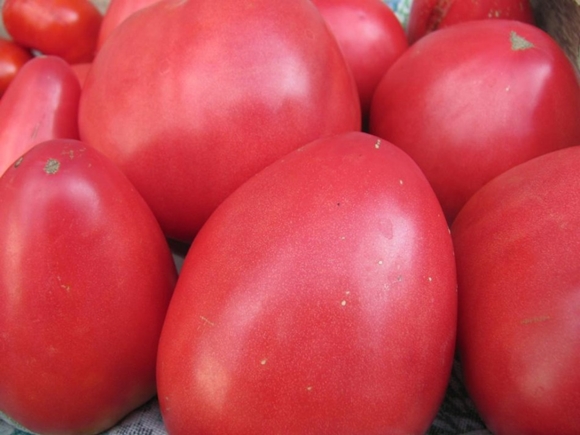
gold fish
The best tomato varieties for the Urals include this bright orange tomato, unusual in appearance. It belongs to the mid-late indeterminants, which in the greenhouse reaches a height of two meters and must be tied up in order to avoid breaking the stem.
Fruit characteristic - deep orange color, elongated shape, high density of the specimen. The weight is small, good, within 100 g.
Reviews of "Goldfish" tomatoes most often note the resistance of this type of nightshade to late blight and cladosporium.
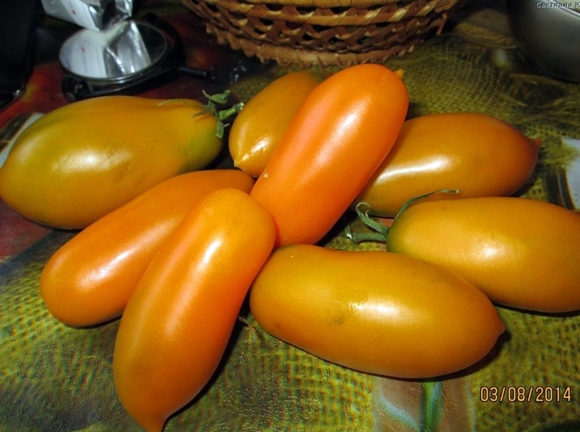
Flame
Early varieties of this type ripen approximately 85 days after the first shoots appear. The plant is a squat, not spreading shrub about half a meter high with a density of 1 m2 up to eight seedlings. This plant is not very picky about lighting and tolerates temperature jumps relatively well, and due to the early simultaneous ripening of fruits, the collection of fruits occurs earlier than there is a risk of infection with late blight.
When ripe, tomatoes are filled with a rich red color, but they grow small - about 70 g. They have a pronounced aroma and give a lot of juice.
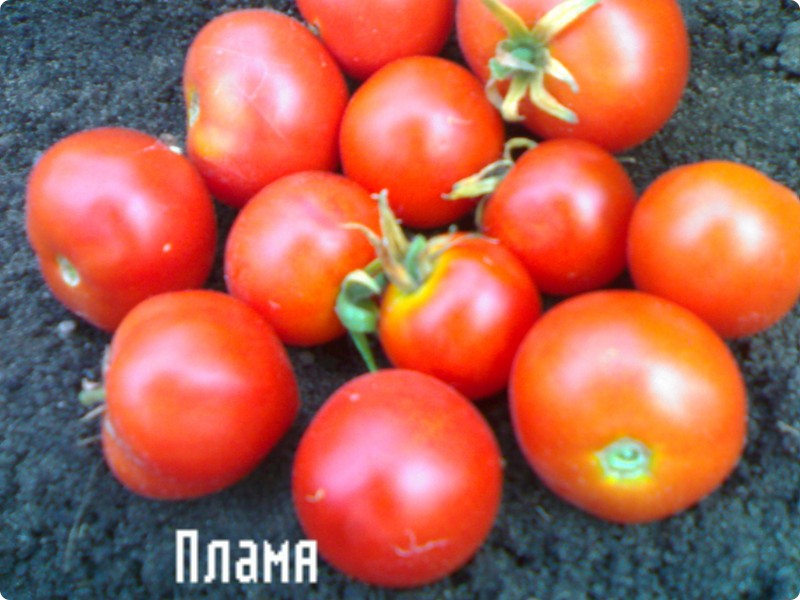
Alaska
As in the case of the previous species, this one presents a fast harvest up to a hundred days from germination, which gives good results for cooler regions with a short summer heat phase. Productivity, subject to agricultural standards, can reach 10 kg from 1 m2 with an average density of six bushes per meter. The height of the bush is small, but due to the increased fragility of the stem, a timely garter of plants is necessary.
The sprout is immune to fusarium, cladosporium. The appearance of the tomato is elliptical, up to 100 g. All fruits are the same in size.

